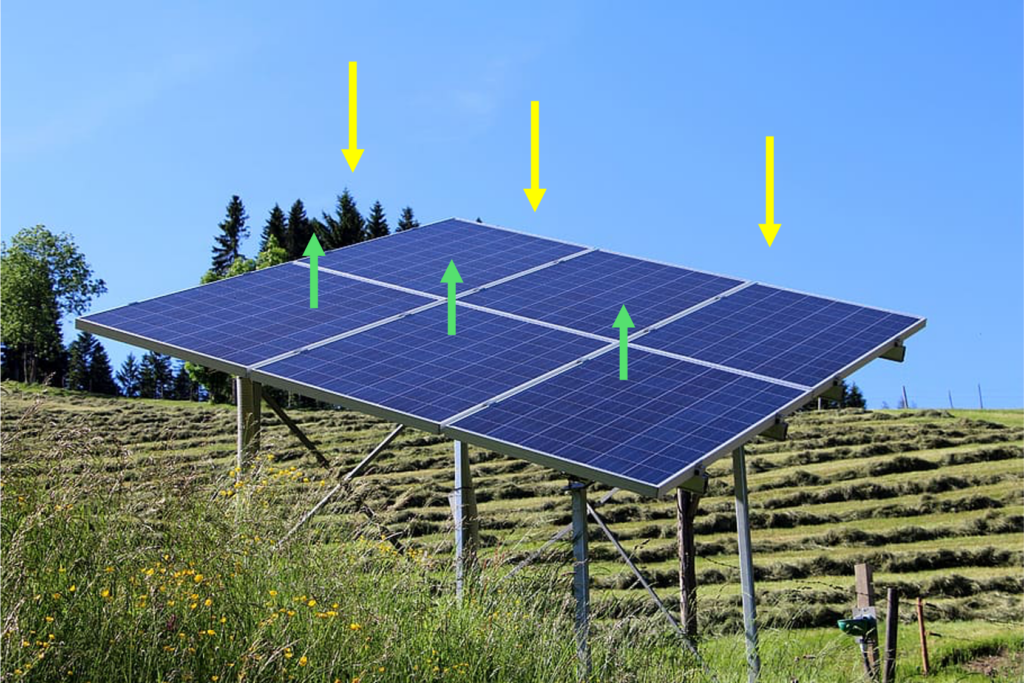Chapter 1: Fundamental Concepts
1.4 Dot Product
A dot product produces a single number to describe the product of two vectors. If you haven’t taken linear algebra yet, this may be a new concept. This is a form of multiplication that is used to calculate work, unit vectors, and to find the angle between two vectors.
[latex]\vec A\cdot \vec B=|\vec A||\vec B|\cos\theta[/latex]
A vector can be multiplied by another vector but may not be divided by another vector. There are two kinds of products of vectors used broadly in physics and engineering. One kind of multiplication is a scalar multiplication of two vectors. Taking a scalar product of two vectors results in a number (a scalar), as its name indicates. Scalar products are used to define work and energy relations. For example, the work that a force (a vector) performs on an object while causing its displacement (a vector) is defined as a scalar product of the force vector with the displacement vector. A quite different kind of multiplication is a vector multiplication of vectors. Taking a vector product of two vectors returns as a result a vector, as its name suggests. Vector products are used to define other derived vector quantities. For example, in describing rotations, a vector quantity called torque is defined as a vector product of an applied force (a vector) and its distance from pivot to force (a vector). It is important to distinguish between these two kinds of vector multiplications because the scalar product is a scalar quantity and a vector product is a vector quantity.
Scalar multiplication of two vectors yields a scalar product.
Dot Product
The scalar product [latex]\vec A\cdot \vec B[/latex] of two vectors [latex]\vec A \text{ and } \vec B[/latex] is a number defined by the equation:
where ϕ is the angle between the vectors. The scalar product is also called the dot product because of the dot notation that indicates it.
When the vectors are given in their vector component forms:
$$\vec A=A_x\underline{\hat{i}}+A_y\underline{\hat{j}}+A_z\underline{\hat{k}}\text{ and }\vec B=B_x\underline{\hat{i}}+B_y\underline{\hat{j}}+B_z\underline{\hat{k}}$$
we can compute their scalar product as follows:
$$\vec A\cdot\vec B=(A_x\underline{\hat{i}}+A_y\underline{\hat{j}}+A_z\underline{\hat{k}})\cdot(B_x\underline{\hat{i}}+B_y\underline{\hat{j}}+B_z\underline{\hat{k}})\\=A_xB_x\underline{\hat{i}}\cdot\underline{\hat{i}}+A_xB_y\underline{\hat{i}}\cdot\underline{\hat{j}}+A_xB_z\underline{\hat{i}}\cdot\underline{\hat{k}}\\+A_yB_x\underline{\hat{j}}\cdot\underline{\hat{i}}+A_yB_y\underline{\hat{j}}\cdot\underline{\hat{j}}+A_yB_z\underline{\hat{j}}\cdot\underline{\hat{k}}\\+A_zB_x\underline{\hat{k}}\cdot\underline{\hat{i}}+A_zB_y\underline{\hat{k}}\cdot\underline{\hat{j}}+A_zB_z\underline{\hat{k}}\cdot\underline{\hat{k}}$$
Since scalar products of two different unit vectors of axes give zero, and scalar products of unit vectors with themselves give one, there are only three nonzero terms in this expression. Thus, the scalar product simplifies to:
[latex]\vec A\cdot\vec B=A_xB_x+A_yB_y+A_zB_z[/latex]
We can use the equation below to find the angle between two vectors. When we divide [latex]\vec A\cdot\vec B=|\vec A||\vec B| \cos\phi[/latex] by [latex]|\vec A || \vec B|[/latex] , we obtain the equation for cos(ϕ), into which we substitute the equation from above:
$$\text{cos}\,\phi =\frac{\overset{\to }{A}·\overset{\to }{B}}{AB}=\frac{{A}_{x}{B}_{x}+{A}_{y}{B}_{y}+{A}_{z}{B}_{z}}{AB}$$
The angle ϕ, between vectors [latex]\vec A \text{ and }\vec B[/latex] is obtained by taking the inverse cosine of the expression above.
Source: University Physics Volume 1, OpenStax CNX, https://courses.lumenlearning.com/suny-osuniversityphysics/chapter/2-4-products-of-vectors (many examples at this page).
But what IS it?
 The dot product is the component of vector A along B ( |A| cos Θ ) times the magnitude (size of B). OR, it’s the component of B on A times the magnitude of A. Visually this can be seen in the figure.[1]
The dot product is the component of vector A along B ( |A| cos Θ ) times the magnitude (size of B). OR, it’s the component of B on A times the magnitude of A. Visually this can be seen in the figure.[1]
There is a nice mathematical proof on page 169 of Calculus-Based Physics.
One neat thing about the dot product is that A • B = B • A
An example of a dot product is in a solar panel. To maximize efficiency, the rays coming from the sun should be perpendicular to the panels, that is, straight on. You could use the dot product between a vector of the sun’s rays (yellow in the image below) and the unit vector perpendicular to the surface (green in the image) to calculate what portion of a ray that comes in at an angle produces energy.

Key Takeaways
Basically: Dot product is a method to find a number that is a product of two vectors.
Application: Two ropes attached to a sign are being pulled in different directions. To find the angle between them, use the dot product of the two vectors.
Looking ahead: We will use the dot product in Section 2.3 on particle equilibrium equations (and more in dynamics next semester).
- Source: https://en.wikipedia.org/wiki/Dot_product#/media/File:Dot_Product.svg ↵

